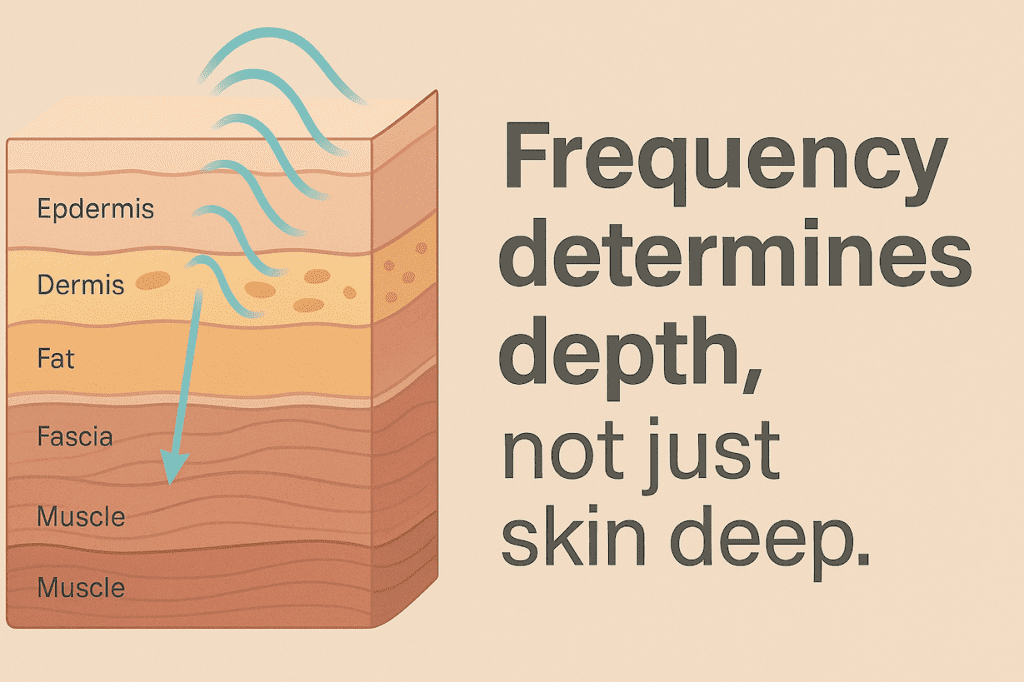
Understanding the 4 Leading RF Treatments: INDIBA, EMFACE, Thermage, and Oligio Compared by Depth and Effectiveness
If you’re looking for an RF facial treatment comparison that goes beyond marketing hype, you’re in the right place. At Sparadise, we compare the four leading non-invasive RF therapies—INDIBA, EMFACE, Thermage, and Oligio—using scientific analysis based on physics and electromagnetic field theory.
Radiofrequency (RF) skin tightening has become a mainstream anti-aging treatment in the world of medical aesthetics. But with so many options—ranging from muscle-focused EMFACE to heavily advertised brands like Thermage and Oligio—many clients struggle to identify which RF therapy actually works.
This article offers RF facial treatment comparison based not on subjective sensations, but on the core principles of wave behavior, penetration depth, and current density distribution. Sparadise’s in-house expertise in RF engineering enables us to evaluate how different frequencies interact with skin, fat, and fascia—revealing why INDIBA provides a deeper, more comprehensive result.
If you’re considering RF skin tightening in Taipei and want to understand which therapy is genuinely effective from a scientific standpoint, this in-depth analysis by Sparadise is your go-to guide.
Bonus: Before-and-after photos of INDIBA treatments.
Feeling Heat ≠ Getting Results: Did Your RF Treatment Really Penetrate?
For many patients undergoing RF treatments, the most common immediate reaction is simply: “That was hot.”
But the real question is: Where did that heat actually go?
From classic options like Thermage and Oligio to newer technologies like INDIBA and EMFACE, RF treatments have continued to evolve, often boasting stronger sensations of heat. But here’s the catch—each RF frequency penetrates to a different depth, and not all of them reach the tissues that truly matter.
In other words, what counts is not how strong the treatment feels, but how deep it goes.
The skin’s surface is not where age-related sagging begins. The real structural layers that determine your facial firmness and contour—fibroblasts, fat tissue, and fascia—lie deeper beneath. If your RF therapy doesn’t reach these foundational layers, it’s unlikely to trigger meaningful regeneration.
That’s why at Sparadise, we believe RF effectiveness should be defined by penetration depth, not just temperature. After all, long-term lifting results come from energy delivered to the right depth—not just to the skin’s surface.
RF Treatment Isn’t Laser or Ultrasound—It’s Electrical Current, and It Attenuates
Many people often confuse radiofrequency (RF) treatments with optical or acoustic technologies, but their physical principles are fundamentally different. Lasers rely on energy delivered through light, while ultrasound works by mechanically vibrating tissue. In contrast, radiofrequency therapy introduces an alternating electric field into the skin, generating a current density wave that penetrates biological tissue.
Once radiofrequency (RF) currents enter the body, they travel between cells and generate heat based on the local conductivity of different tissues. This thermal effect is known as Joule heating, and it leads to several key physiological benefits:
- Stimulates fibroblasts to promote new collagen production
- Enhances local blood circulation and metabolic activity
- Regulates fascial tension, improving structural support within the tissue
But here’s the catch: these electrical currents attenuate rapidly with depth. Whether they reach the fibroblasts, fat metabolism zones, or even deeper layers like muscle and fascia depends entirely on the frequency and waveform design of the treatment.
This is precisely why the penetration depth of INDIBA is significantly greater than that of high-frequency RF devices like Thermage and Oligio—making it a fundamentally more effective solution for deep-tissue rejuvenation.
The Human Body Isn’t Just Skin—It’s a Layered Electrical Structure
In practical analysis, the human body is best understood as a multi-layered conductive structure composed of different tissue types arranged in series. This model is often represented using an equivalent electrical circuit, which helps us determine how far an RF current actually penetrates—and where it gets reflected or dissipated.
Broadly speaking, the body’s key conductive layers can be divided into three:
| Tissue Layer | Thickness | Conductivity | Description |
|---|---|---|---|
| Epidermis & Dermis | ≈ 2mm | Moderate($\sigma$ = 0.2 S/m) | Contains fibroblasts and serves as the primary target for many superficial, heat-based treatments. |
| Subcutaneous Fat | ≈ 10mm | Low($\sigma$ = 0.04 S/m) | Tends to reflect or attenuate high-frequency RF, making it a major barrier for effective penetration in many treatments. |
| Muscle Layer | ≈ 30mm | High($\sigma$ = 0.5 S/m) | Once reached, this layer enables highly efficient heating and effectively stimulates deep-tissue regeneration. |
As illustrated, the actual path of electric current through the human body is a series of regions with varying electrical conductivity.
- Epidermis and dermis (~2 mm): Moderate conductivity. These layers contain fibroblasts and are the primary targets of superficial, heat-intensive treatments.
- Subcutaneous fat (~10 mm): Low conductivity with higher electrical resistance. This layer tends to reflect or absorb high-frequency RF, becoming a major barrier for many treatments.
- Muscle and fascia (~30 mm): High conductivity. When RF energy reaches this level, Joule heating becomes highly efficient, allowing effective deep-tissue remodeling.
As shown in the diagram, the actual path of RF current through the body is not uniform, but a journey through zones of varying conductivity.
This difference in electrical properties explains why high-frequency RF treatments often produce intense surface heat but fail to reach deeper tissues like fat and muscle.
In contrast, low-frequency RF systems like INDIBA deliver energy more evenly across all three layers, reaching target structures without overheating the skin.
Understanding this “series conductive model” is the first step toward making an informed RF treatment comparison—and understanding why INDIBA’s penetration depth offers such a distinct clinical advantage.
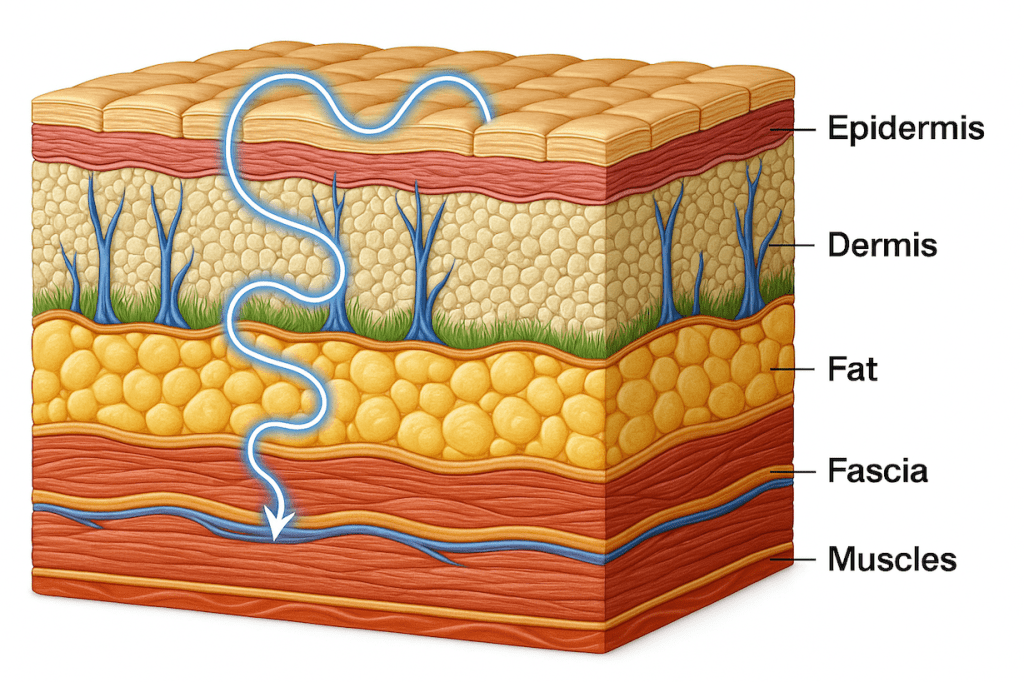
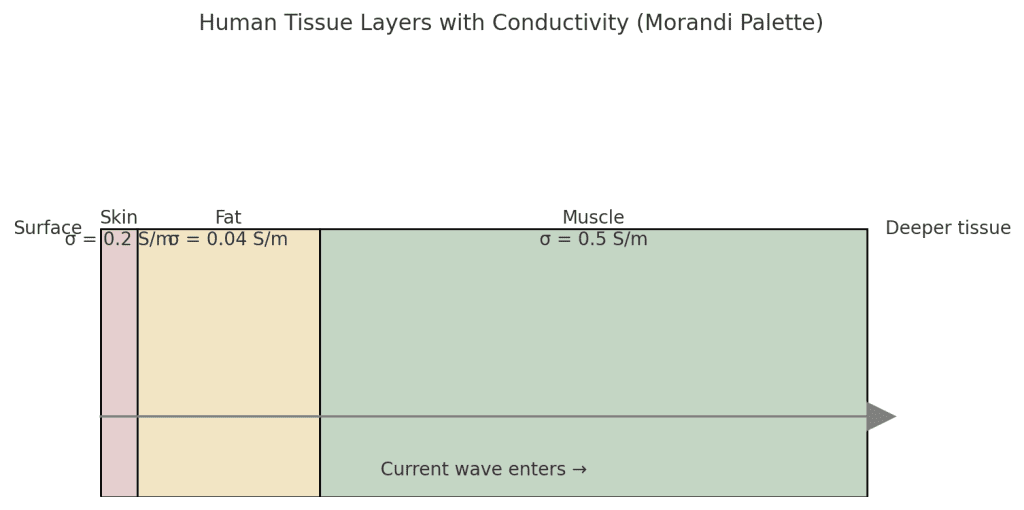
How Deep Does It Go? It Depends on Frequency and Tissue Impedance
At Sparadise, our analysis doesn’t rely on marketing brochures from equipment manufacturers. Instead, we go back to the fundamentals of electromagnetic theory.
The concept of penetration depth is rooted in Maxwell’s equations, which describe how electromagnetic fields propagate, attenuate, and distort as they move through a medium. These four equations are the foundation for understanding how electromagnetic waves behave—especially when they enter non-ideal conductors like the human body.
In such environments, electromagnetic waves give rise to current density waves, which undergo amplitude decay and phase delay. These effects critically influence where energy is actually deposited, and thus determine the biological effectiveness of any RF-based treatment.
Step 1: Identify the Two Key Maxwell Equations Driving Field Interaction
To understand how electric and magnetic fields generate and influence each other, we focus on the following two equations from the full Maxwell set:
1. Faraday’s Law of Induction
This law states that a time-varying magnetic field produces a circulating electric field. It’s central to understanding how RF systems induce current within tissue:
$$
\nabla \times \mathbf{E} = -\frac{\partial \mathbf{B}}{\partial t}
$$
Ampère-Maxwell Law
This law describes how a time-varying electric field produces a magnetic field, completing the dynamic interaction between electric and magnetic fields in an RF system. It’s essential for understanding how electric energy creates circulating magnetic fields in biological tissues:
$$
\nabla \times \mathbf{H} = \mathbf{J} + \frac{\partial \mathbf{D}}{\partial t}
$$
In a conductive medium such as the human body, the following relationship holds:
- $\mathbf{D} = \varepsilon \mathbf{E}$
- $\mathbf{B} = \mu \mathbf{H}$
- $\mathbf{J} = \sigma \mathbf{E}$
Step 2: Apply the Equations to Derive the Electric Field Wave Equation
To begin, we take the curl of Faraday’s Law:
$$
\nabla \times (\nabla \times \mathbf{E}) = -\frac{\partial}{\partial t} (\nabla \times \mathbf{B})
$$
Next, we substitute $\nabla \times \mathbf{B} = \mu \left( \mathbf{J} + \frac{\partial \mathbf{D}}{\partial t} \right)$ into the right-hand side:
$$\nabla \times (\nabla \times \mathbf{E}) = -\mu \frac{\partial}{\partial t} \left( \sigma \mathbf{E} + \varepsilon \frac{\partial \mathbf{E}}{\partial t} \right)$$
We now apply the vector identity:
$$\nabla \times (\nabla \times \mathbf{E}) = \nabla(\nabla \cdot \mathbf{E}) – \nabla^2 \mathbf{E}$$
Assuming there are no free charges (i.e. $\nabla \cdot \mathbf{E} = 0$), we simplify the equation as follows:
$$\nabla^2 \mathbf{E} = \mu \left( \sigma \frac{\partial \mathbf{E}}{\partial t} + \varepsilon \frac{\partial^2 \mathbf{E}}{\partial t^2} \right)$$
This is the electric field wave equation in a lossy medium.
Step 3: Apply a Time-Domain Fourier Solution to Derive the Wave Number $k$
We assume the wave takes the following form:
$$\mathbf{E}(z, t) = \tilde{\mathbf{E}}(z) e^{-j\omega t}$$
Substituting into the previous equation, we obtain:
$$\frac{d^2 \tilde{\mathbf{E}}}{dz^2} = -\mu \left( j \omega \sigma + \omega^2 \varepsilon \right) \tilde{\mathbf{E}} = -k^2 \tilde{\mathbf{E}}$$
Therefore,
$$k = \omega \sqrt{ \mu \left( \varepsilon – j \frac{\sigma}{\omega} \right) } = \omega \sqrt{ \mu \tilde{\varepsilon} }$$
Here, $\tilde{\varepsilon} = \varepsilon’ – j \varepsilon^{\prime\prime}$ is defined as the complex permittivity.
Step 4: Physical Interpretation — What Are $\varepsilon’$ and $\varepsilon^{\prime\prime}$?
- $\varepsilon’$:Ability to store energy in the medium (polarization effect)
- $\varepsilon^{\prime\prime}$:Measure of energy loss (represents dissipation), defined as:
$$\varepsilon^{\prime\prime} = \frac{\sigma}{\omega}$$
This means that the higher the conductivity and the lower the frequency, the more easily energy is lost along the way—primarily as heat.
Step 5: The Wave Number kk Is Complex—And It Causes Attenuation
The complex wave number can be expressed as: $$k = \beta – j\alpha$$
- $\beta$:Rate of phase change (wavelength)
- $\alpha$:Attenuation constant, representing the rate at which amplitude decreases with distance
Therefore, the behavior of the electric field and current density waves can be expressed as:
$$\mathbf{E}(z, t) = \mathbf{E}_0 e^{-\alpha z} e^{j(\beta z – \omega t)}$$
$$\mathbf{J}(z, t) = \sigma \mathbf{E}(z, t)$$
Step 6: Definition and Formula for Penetration Depth
We define penetration depth as the depth at which the electric field or current density has decayed to $1/e$ of its original value:
$$\delta(f) = \frac{1}{\alpha}$$
The derivation is as follows:
$$\delta(f) = \frac{1}{\omega \sqrt{\mu \cdot \left( (\varepsilon’)^2 + (\varepsilon^{\prime\prime})^2 \right)^{1/4} \cdot \cos\left( \frac{1}{2} \tan^{-1} \left( \frac{\varepsilon^{\prime\prime}}{\varepsilon’} \right) \right)}}$$
The penetration depth formula used in this article is derived directly from the electromagnetic theory outlined above. It serves as the foundation for evaluating the penetration differences among leading RF treatments: INDIBA, EMFACE, Thermage, and Oligio.
This is not based on clinical impressions or brand claims—it is a result grounded in classical electromagnetic field theory.
As shown in the diagram below, when an electromagnetic wave and its induced current enter a lossy medium such as human tissue perpendicularly, the energy decays exponentially with depth.
The frequency and waveform used in each treatment determine how deep the energy is deposited and which tissue layers are actually affected.
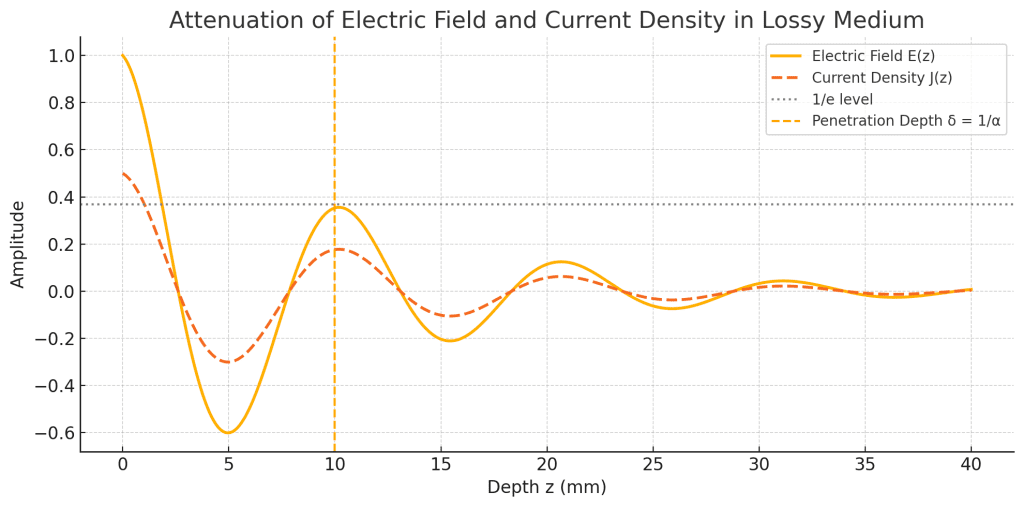
This figure illustrates how the electric field $E(z)$ and current density $J(z)$ decay with depth in a lossy mediumsuch as skin or fat.
The vertical dashed line at $1/e$ defines the penetration depth $δ$, where energy has dropped to approximately 36.8%of its original value.
This physical principle forms the basis for our subsequent evaluation of tissue-level energy delivery in INDIBA, EMFACE, Thermage, and Oligio treatments.
Electromagnetic Analysis Confirms: INDIBA Penetrates Deepest and Delivers the Most Comprehensive Effects
Do Different RF Frequencies Truly Reach Different Depths?
To answer this question, we applied the penetration depth formula derived earlier from Maxwell’s equations, and constructed a three-layer conductive model representing skin, fat, and muscle.
For each RF treatment, we calculated the depth at which the current density wave attenuates to $1/e$ (approximately 36.8%) of its original amplitude in each tissue layer.
This value—also known as the effective penetration depth—is a key indicator of whether a treatment delivers sufficient energy to stimulate deeper structures.
The results below show the computed penetration depths for four leading RF treatments, based on their typical operating frequencies.
| Treatment Name | RF Treatment | Effective Penetration Depth $\delta$ | Target Tissue Layer |
|---|---|---|---|
| INDIBA | 448 kHz | ≈ 27.1 mm | Penetrates skin and fat, reaches muscle layer |
| EMFACE | 3.2 MHz | ≈ 9.9 mm | Reaches deep into the fat layer, approaching the muscle surface |
| Thermage | 6.78 MHz | ≈ 6.9 mm | Dermal-fat junction |
| Oligio | 6.78 MHz | ≈ 6.9 mm | Dermal-fat junction |
To present a more intuitive view of the relationship between operating frequency and penetration depth across different RF treatments, we created the log-log plot shown below. The X-axis represents frequency (in Hz, logarithmic scale), and the Y-axis represents penetration depth (in mm, also on a logarithmic scale). Each point on the graph corresponds to the typical operating parameters of a specific RF treatment.
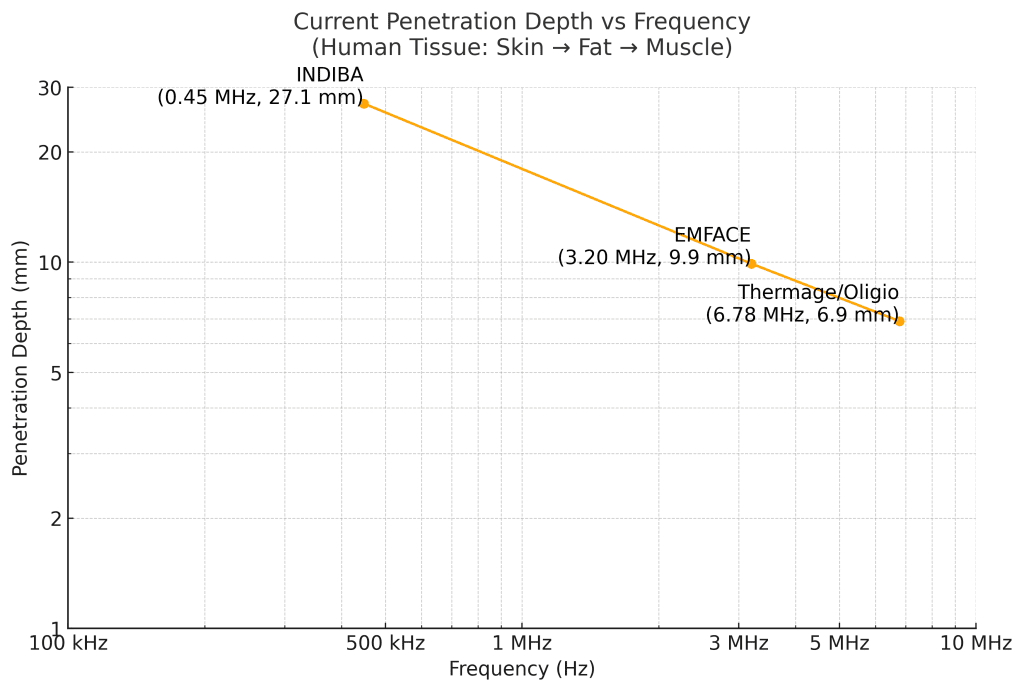
Analysis of results and clinical implications
As shown in the chart, INDIBA demonstrates a significantly greater penetration depth than the other RF treatments. Its energy reaches beyond the subcutaneous fat, penetrating into muscle and fascia layers, offering true potential for deep tissue remodeling.
EMFACE, which operates in the mid-frequency range, does not reach as deep as INDIBA, but still penetrates the lower fat layer and stimulates the superficial muscle, providing a moderate depth of activation.
By contrast, Thermage and Oligio, though widely marketed for “RF lifting,” operate at a high frequency of 6.78 MHz, which causes the energy to concentrate mainly within the dermis and superficial fat layers. These treatments are less likely to affect fascia or deeper fat, and are therefore more suitable for surface tightening than structural rejuvenation.
These findings also help explain the differences often observed in clinical feedback.
INDIBA users frequently report minimal surface heat but notice deeper, more solid improvements over time. In contrast, high-frequency RF treatments may feel intensely warm on the surface, offering short-term tightness but limited impact on deeper support structures.
All penetration depth values presented here are calculated using Ampère’s Law and a complex conductivity model, applied to a layered tissue simulation. These results are not based on subjective impressions or manufacturer claims—they are derived from repeatable electromagnetic theory and conductive tissue modeling.
Conclusion
In RF therapy, the core issue is not simply heat, but depth. Only RF energy that truly reaches the fat and muscle layers can stimulate deep collagen renewal and drive structural regeneration. At Sparadise, we let physics and penetration models guide our treatments—so that every session targets the exact layer you want to improve.
Choose the right treatment—reach the depth that truly matters.
The effectiveness of RF treatments has never been determined by marketing hype—it is determined by the laws of physics: The higher the frequency, the shallower the penetration.
Facial laxity, puffiness, and loss of elasticity are not caused by a thinner epidermis. They stem from fatigue in the deeper structural layers that support the skin. That’s why true regeneration can only happen when energy is precisely delivered to the right depth—the layers where collagen is produced and tissue can be rebuilt.
For example, fibroblasts, the primary source of collagen and elastic fibers, are concentrated near the junction of the dermis and fascia. Meanwhile, deep puffiness or sagging often originates at the boundary between fat and muscle, which requires at least 1 cm of penetration depth to be effectively addressed.
Sparadise Expert Analysis: Matching Four RF Treatments to Tissue Targets and Clinical Goals
| Treatment Name | Primary Penetration Layer | Target Anatomical Structure | Best-Suited Clinical Indications |
|---|---|---|---|
| INDIBA | Penetrates into muscle and fascia | Fascia, Fibroblasts, and Deep circulation | Long-term contour repair |
| EMFACE | From fat to superficial muscle layer | Mid-level muscle and fibroblasts | Contour enhancement |
| Thermage | Dermis | Superficial fibroblasts | Surface tightening, fine lines, and immediate lifting effect |
| Oligio | Dermis | Superficial fibroblasts | Early-stage laxity and skin density improvement |
The key has never been about how “hot” a treatment feels— it’s about whether the RF energy truly reaches the regenerative cellular layers.
At Sparadise, we believe in this sequence:
Choose the right frequency → Reach the right depth → Activate the right cells → Reverse structural aging.
This is the foundation of why we confidently recommend the INDIBA® treatment.
If you’d like to understand whether your skin condition is suitable for INDIBA, we’re happy to provide you with a technical explanation and personalized assessment. Sparadise is not just about operating a machine—we’re committed to helping every client understand what happens beneath the surface, and to ensure that your treatment truly reaches the layer you want to transform.
You Don’t Have to Believe the Ads—But You Should Believe the Physics: Only INDIBA Goes Beyond the Limits of Surface Treatments.
Starting from Ampère’s Law, we extend the calculation of penetration depth into a realistic human tissue model—skin, fat, and muscle. We don’t just write formulas—we map the exact tissue layer you want to improve, and make sure the current reaches it with precision.
We’ve always known: Intense heat doesn’t equal true effectiveness. An effective treatment is one that penetrates, activates, and restores. Whether your fibroblasts get reactivated is not about how “hot” it feels—it’s about whether the energy reaches the right layer.
This is the foundation of Sparadise’s logic and technical philosophy:
- We seek to understand your true goals: facial laxity, puffiness, fatigue, or long-term structural care?
- We’re not afraid to explain or to be compared—because our work is grounded in electromagnetic physics and energy modeling, not just sensation or advertising.
If you’re tired of treatments that feel hot but deliver little, then you’ll appreciate the INDIBA® RF therapy at Sparadise—a technology designed to work where real structural change happens: beneath the surface.
We welcome you to book a consultation. Let us guide you to a treatment that truly reaches the depth your skin needs.
FAQ|Your Top Questions About INDIBA Answered
Q: What Is the Science Behind the INDIBA® Treatment?
A: INDIBA® uses 448 kHz radiofrequency energy to stimulate cellular and tissue regeneration, accelerate the repair process, and reduce pain and inflammation. It is widely used in aesthetic treatments, sports recovery, and medical therapy, with its safety and effectiveness clinically proven.
Q: Does the INDIBA® treatment cause pain?
A: No, INDIBA® is a non-invasive and gentle therapy. During the treatment, patients typically feel a mild warming sensation, and many even find the session relaxing—some even fall asleep during the procedure.
Q: Is the INDIBA® treatment safe?
A: Yes, INDIBA® is CE and FDA certified, and its safety has been confirmed through clinical studies. It is non-invasive, requires no downtime, and does not interfere with daily activities.
Q: How long do the effects of the INDIBA® treatment last?
A: The effects of a single INDIBA® session can last for several weeks. With multiple sessions, the results become longer-lasting. Regular maintenance and a healthy lifestyle help prolong the benefits.
Q: Can INDIBA® be combined with other treatments?
A: Yes, INDIBA® can be combined with other aesthetic or medical treatments to enhance results and shorten recovery time. It is commonly used for post-operative recovery, anti-aging protocols, and body contouring.
Q: Can I receive the INDIBA® treatment if I have an intrauterine device (IUD)?
A: If you have a metal IUD, the 448 kHz frequency is not contraindicated. However, if you have a hormonal IUD, prolonged and direct high-temperature treatment in the uterine area should be avoided, as it may reduce contraceptive effectiveness.
Q: Can people undergoing hormone therapy receive the INDIBA® treatment?
A: Yes, INDIBA® is not contraindicated for individuals undergoing hormone therapy. However, we recommend consulting your healthcare provider before starting the treatment.
Q: Can I receive the INDIBA® treatment during my menstrual period?
A: Yes, menstruation is not a contraindication. If you feel comfortable, you can proceed with the treatment. However, because INDIBA® increases metabolic activity, some individuals may experience heavier menstrual flow on the day of treatment. If you feel uncomfortable with perineal treatments (external or internal), please inform your therapist so the session can be adjusted accordingly.
Q: Can the INDIBA® treatment affect a transvaginal mesh?
A: No, INDIBA® does not affect a transvaginal mesh if there are no related complications or symptoms. Please consult your healthcare provider for personalized advice.
Q: Can I receive the INDIBA® treatment during pregnancy?
A: Yes, INDIBA® can help relieve menopause-related vaginal dryness and itching by restoring the vaginal mucosa and improving symptoms. Please consult your healthcare provider for more detailed information.
Q: Can I receive the INDIBA® treatment if I have an implanted electronic device (such as a neurostimulator)?
A: No, this is an absolute contraindication. INDIBA® can only be used with removable electronic implants. If your device cannot be removed or turned off, you should not undergo INDIBA® treatment.
Q: Can I exercise after an INDIBA® treatment?
A: If high temperatures were applied to an injured area, intense training should be avoided on the same day. The analgesic effect of the treatment is strong, and you may unknowingly place excessive strain on the treated area.
Q: Is INDIBA® suitable for women going through menopause?
A: Yes, INDIBA® can help relieve menopause-related vaginal dryness and itching by restoring the vaginal mucosa and improving symptoms. Please consult your healthcare provider for more detailed information.
Q: Does the intracavitary electrode used in the INDIBA® treatment cause pain?
A: No, but you may feel some discomfort during insertion or removal of the electrode, depending on the flexibility of the treatment area. A healthcare professional will assess your condition and obtain your consent before performing any internal or external treatment.
Here’s how you can make an appointment with Sparadise:
- Package Offer: Enjoy exclusive discounts on multiple-session treatments. Contact us for details.
- Reservation Hotline: (02) 2325-3257
- Booking Online: Whatsapp, LINE
- Address: No. 15-1, Ln. 26, Aly. 118, Wuxing St., Xinyi Dist., Taipei City, Taiwan (near Taipei 101, free parking available)


